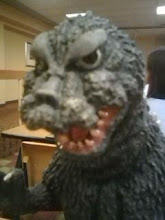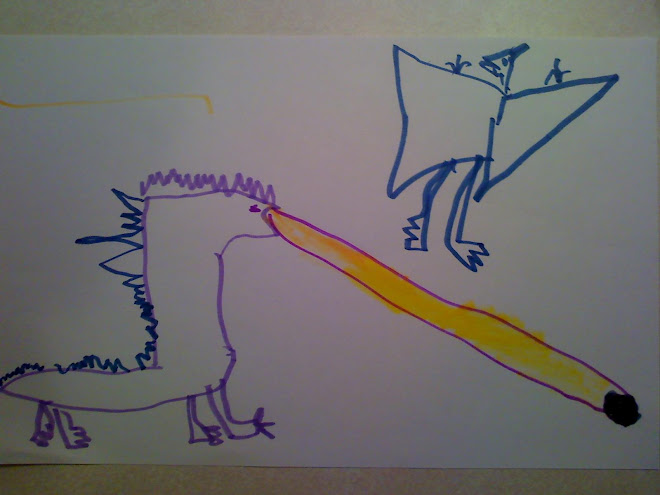This article first appeared in Martin Arlt's fanzine "Mad Scientist" #22, which is now sold out. Inspired by the season premiere of Finding Bigfoot, I have reproduced my salute to Boggy Creek here.
On the Track of the
Ultimate Bigfoot Movie:
“The Legend of Boggy
Creek”
Bigfoot and
I go way back. I owe my introduction to the hairy hominid to Sid and Marty
Krofft, whose “Krofft Supershow” (1976) featured fifteen-minute episodes of “Bigfoot
and Wildboy.” Needless to say, my four-year-old self envied Wildboy’s
friendship with the big biped, and the show inspired many imaginary adventures
played out in the wilderness of my basement. The same year saw Steve Austin
tangling with Bigfoot (as played by both wrestler Andre the Giant and actor Ted
Cassidy) on “The Six Million Dollar Man.
Over the
next couple of years, I could not help but dig deeper into Bigfoot lore, and
since my research took place during the “Bigfoot Boom” of the 1970s, my local
library yielded no shortage of Sasquatchiana. Marian T. Place Pacific Northwest . It wasn’t until I got my hands on
works such as Elwood Baumann’s “Monsters of North America” and Place’s
subsequent “Bigfoot All Over the Country” that I learned that reports of giant
man-apes were far more widespread than I had been led to believe. What is more,
Baumann’s book devoted three whole chapters to a series of sightings in Fouke , Arkansas
For years,
Baumann’s description of “The Legend of Boggy Creek” fired my imagination, and
I had come to accept that the images it produced in the theater of my mind
would probably have to suffice. My hopes for seeing the film would rise,
however, whenever it was mentioned in books such as Janet and Colin Bord’s “The
Bigfoot Casebook”—at the very least, I could take comfort in knowing the movie
really existed, and that someone, somewhere had seen it.
And then
one day, in my early teens, it appeared. There, in the television listings,
which I habitually scoured for monsters of all persuasions, was the title: “The
Legend of Boggy Creek.” It was scheduled to run far too late for me to stay up
and watch, but fortunately, my family had purchased our first Video Cassette
Recorder. With the precision of a surgeon I set the timer, double-checking my
work, and then it was done--all I could do was wait and hope.
The next
morning I rewound the tape, took a deep breath, and pushed play. These orange
words appeared against a plain black background: “THIS IS A TRUE STORY. Some of
the people in this motion picture portray themselves—in many cases on actual
locations.” After years of waiting, the legendary Bigfoot was in my possession.
When I
finally had the long-awaited pleasure of watching “The Legend of Boggy Creek,”
I was not disappointed—if anything, it was more absorbing than I had hoped.
Moreover, it felt plausible, and some of the vignettes were genuinely
unnerving, beginning with a sequence in which a young boy runs from the sound
of a howling Bigfoot, admitting in voiceover that “I was seven years old when I
first heard him scream. It scared me them, and it scares me now.”
After
quickly establishing the geography and general culture of Fouke (which is to
say, the Deep South of the early 70s), two
eyewitnesses report their experiences on location in a matter-of-fact tone that
roots the proceedings in reality. One of the men eerily relates the tale of his
two-hundred pound show hogs being carried away—by something—over a barbed wire fence.
Two
re-enactments follow, in which hunters run across the creature ambling through
the woods. These scenes avoid sensationalism and give the viewer a sense of
what seeing an unknown creature must be like. The costume used for these scenes
is effective, in that it is never glimpsed in much detail, and the suit actor
moves about naturally, giving the impression of something large and hairy yet
not abnormal.
Next, three
women and a baby living in a back-country shack are terrorized by a nighttime
visit from the creature. The monster’s appearance is only hinted at, yet the
sequence is gripping. It also concludes with a mildly disturbing image of a cat
that had been “scared to death” by its close encounter with the cryptid.
That is
followed by an intense segment in which an adolescent hunter brings the hominid
to its knees with a couple of rifle shots. The young actor in this segment is
convincingly spooked, and the viewer is, too.
The film
offers a slight breather at this point, showing hunting parties and tracking
dogs searching in vain for Bigfoot. More unpredictably, a musical montage
begins! The plaintive “Ballad of Boggy Creek,” written by Earl E. Smith (and
probably sung by Charles B Pierce), is set to shots of both the natural beauty
of the Sulphur River
“Here the Sulfur River
As one musical interlude ends,
another takes its place. This one is dedicated to Travis Crabtree, a teenage
trapper and outdoorsman. We learn that Travis, in his forays up and down the
river, occasionally visits Herb Jones, a man who lives in seclusion deep in the
swamps. Jones, who seems like someone who should know, steadfastly declares
that “there ain’t no such thing” as the Fouke Monster.
Jones’
denial notwithstanding, evidence is presented in the form of large, three-toed
footprints, discovered in a bean field. This serves a transition to another
recreated sighting. Three young children lead their aunt to the place where
they claim they saw “a wild man”—and right on cue, he appears upon their return.
It is a simple set-up, made effective by the panicked reaction of the woman,
who paradoxically screams “Don’t run!” as the group flees in horror.
The scene
that follows is one of my favorites, because it depicts a staple of Bigfoot
sighting lore: the old “road crossing” scenario. It happens quickly—in less
than five seconds, the thing has crossed the road and hidden in the woods. This
is a situation I had read about and visualized for years, and to see it
captured on film was oddly thrilling.
Another
creepy vignette portrays the monster stalking a trailer full of teenage girls.
Their fear is palpable as they pull out Daddy’s gun and fumble for bullets on
the kitchen floor. When one of the girls musters up the courage to peek out the
window, the viewer knows what is coming, yet it is hair-raising all the same.
The final
portion of the movie is its longest set piece; an account of the events
experienced by the Ford family as something Big tries to enter their homestead.
The most dramatic elements of the real-life Ford encounter (as documented in
Baumann’s book) are brought to life, such as a hairy hand reaching in through
an open window, and Bobby Ford crashing in through the screen door in an effort
to escape the creature’s clutches.
Unfortunately,
this sequence features both the most and least convincing monster appearances
in the film. When the shadow of the creature slinks across the porch, and the
boards creak under its weight, the effect is chilling. However, when Bobby Ford
finally collides with the creature in the front yard, an ill-fitting gorilla
mask, complete with loose eyeholes, is easily glimpsed by the viewer, and the
spell of suspense is broken. That is the only misstep that the movie makes in
portraying the monster, and it is a shame that it takes place during what is
effectively the climax of the film.
“Boggy
Creek’s” denouement is a moody shot of a man (the narrator and grown-up version
of the boy in the prologue) inspecting an old cabin while reflecting, in
voice-over, on the mystery of the Fouke sightings. The viewer almost expects
one last shock to occur, but it never does, and the movie seems to coast to a
stop, like the funhouse ride it is.
Charles B.
Pierce caught lightning in a bottle with “The Legend of Boggy Creek,” managing
not only to bring the Fouke Phenomena to light, but also to preserve a snapshot
of Southern culture in a way that does not feel exploitative. Whether by design
or budgetary necessity, “Boggy Creek” is a study in understatement, which is
perhaps a strange thing to say about a Bigfoot movie. What is far stranger is
that Pierce would take precisely the opposite approach in filming “Boggy Creek
II: And The Legend Continues…” in 1985, employing crude Southern caricature,
mild lasciviousness, and much monstrous melodrama. It is a film custom-made for
the Mystery Science Theater 3000 treatment, which it received in 2004. (At one
point, host Mike Nelson quips, “With a degree in Boggy Creek studies you can
pretty much write your own ticket.”) While it makes for a fantastic MST3K
episode, “Boggy Creek II” raises questions about Pierce’s true feelings for the
subject matter, illustrating that there is a fine line between cult classic and
B-movie embarrassment.
In addition
to Pierce’s own ill-conceived “sequel,” “The Legend of Boggy Creek” inspired a
wave of Sasquatch cinema, such as 1975’s “The Mysterious Monsters,” a
straightforward documentary narrated by Peter Graves; 1976’s “The Creature from
Black Lake,” an affable tale featuring the menacing talent of Jack Elam; and
1978’s “Sasquatch: the Legend of Bigfoot,” which seems consciously patterned
after “Boggy Creek’s” docudrama structure. Bigfoot stomped his way onto the
small screen as well, in the aforementioned “Bigfoot and Wildboy” and “Six
Million Dollar Man” series, as well as more sober fare such as the Leonard
Nimoy-narrated “In Search Of…” Pierce, who died on March 5, 2010, helped make
Bigfoot a household name in the 1970s, and in the process enjoyed modest
financial success.
The
peculiar, haunting quality of “The Legend of Boggy Creek” gave some viewers not
just a few moments of escapist entertainment, but a calling to pursue. In his
book “Bigfoot! The True Story of Apes in America Arkansas
Bibliography
Bauman, Elwood (1978). Monsters of North
America . Xerox Education Publications. U.S.A.
Bord, Janet and Colin (1982). The Bigfoot Casebook.
Stackpole Books. Harrisburg ,
PA.
Coleman, Loren (2003). Bigfoot! The True Story of Apes in America New York ,
NY
Place, Marian T (1974). On the Track of Bigfoot. Dodd, Mead
& Company. New York , NY



































































Great article! This movie has become part of our family culture. Your analysis of the docudrama format explains the appeal of the movie. You brought back a lot of great memories.
ReplyDeleteMarybeth! You better put a blanket on the baby...
ReplyDelete